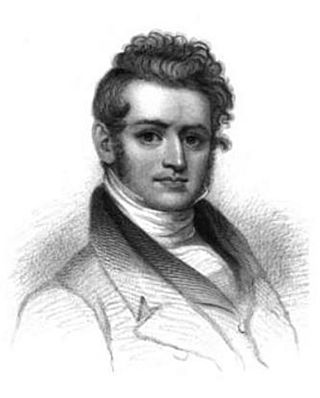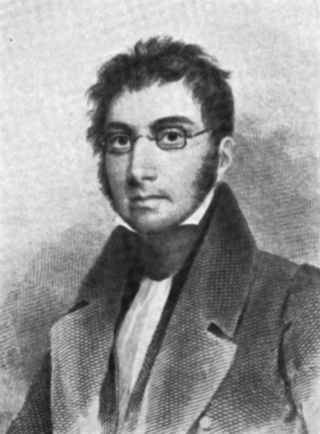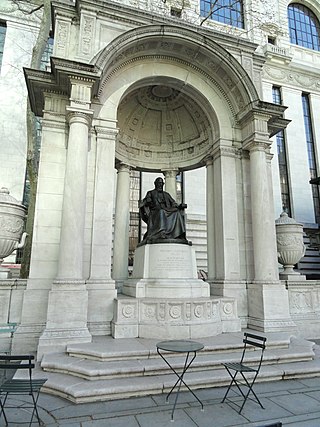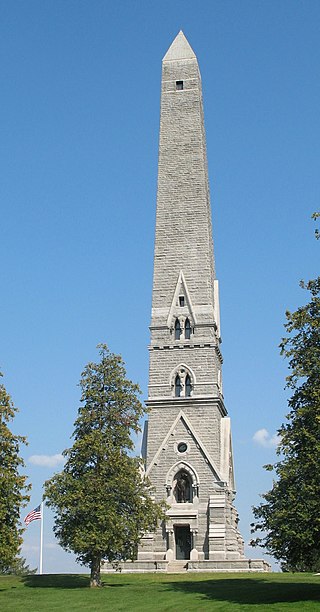
The Dean Cemetery is a historically important Victorian cemetery north of the Dean Village, west of Edinburgh city centre, in Scotland. It lies between Queensferry Road and the Water of Leith, bounded on its east side by Dean Path and on its west by the Dean Gallery. A 20th-century extension lies detached from the main cemetery to the north of Ravelston Terrace. The main cemetery is accessible through the main gate on its east side, through a "grace and favour" access door from the grounds of Dean Gallery and from Ravelston Terrace. The modern extension is only accessible at the junction of Dean Path and Queensferry Road.

William Cullen Bryant was an American romantic poet, journalist, and long-time editor of the New York Evening Post. Born in Massachusetts, he started his career as a lawyer but showed an interest in poetry early in his life. He soon relocated to New York and took up work as an editor at various newspapers. He became one of the most significant poets in early literary America and has been grouped among the fireside poets for his accessible, popular poetry.

Joseph Rodman Drake was an early American poet.

Fort Greene Park is a city-owned and -operated park in Fort Greene, Brooklyn, New York City. The 30.2-acre (12.2 ha) park was originally named after the fort formerly located there, Fort Putnam, which itself was named for Rufus Putnam, George Washington's Chief of Engineers in the Revolutionary War. Renamed in 1812 for Nathanael Greene, a hero of the American Revolutionary War, it was redesigned by Frederick Law Olmsted and Calvert Vaux, who also designed Central Park and Prospect Park, in 1867. The park contains the Prison Ship Martyrs' Monument, which includes a crypt designed by Olmsted and Vaux.

Sir John Robert Steell was a Scottish sculptor. He modelled many of the leading figures of Scottish history and culture, and is best known for a number of sculptures displayed in Edinburgh, including the statue of Sir Walter Scott at the base of the Scott Monument.
Events from the year 1876 in art.

Bayard Taylor was an American poet, literary critic, translator, travel author, and diplomat. As a poet, he was very popular, with a crowd of more than 4,000 attending a poetry reading once, which was a record that stood for 85 years. His travelogues were popular in both the United States and Great Britain. He served in diplomatic posts in Russia and Prussia.

Fitz-Greene Halleck was an American poet and member of the Knickerbocker Group. Born and raised in Guilford, Connecticut, he went to New York City at the age of 20, and lived and worked there for nearly four decades. He was sometimes called "the American Byron". His poetry was popular and widely read but later fell out of favor. It has been studied since the late twentieth century for its homosexual themes and insights into nineteenth-century society.

Robert Charles Sands was an American writer and poet.
Poets' Walk is located in Red Hook, New York, United States on the River Road. It is intended to celebrate the connection between landscape and poetry. The classic wooden vistas, sunlit fields and thick forest were the main focus of landscape architect Hans Jacob Ehlers' vision for the property in 1849.

James Grant Wilson was an American editor, author, bookseller and publisher, who founded the Chicago Record in 1857, the first literary paper in that region. During the American Civil War, he served as a colonel in the Union Army. In recognition of his service, in 1867, he was nominated and confirmed for appointment as a brevet brigadier general of volunteers to rank from March 13, 1865. He settled in New York, where he edited biographies and histories, was a public speaker, and served as president of the Society of American Authors and the New York Genealogical and Biographical Society.
The Speaker of the Legislative Assembly of Prince Edward Island is the presiding officer of the provincial legislature.

Brevet Lt. General Winfield Scott is an equestrian statue in Washington, D.C., that honors career military officer Winfield Scott. The monument stands in the center of Scott Circle, a traffic circle and small park at the convergence of 16th Street, Massachusetts Avenue and Rhode Island Avenue NW. The statue was sculpted by Henry Kirke Brown, whose best-known works include statues of George Washington in New York and Nathanael Greene in Washington, D.C. It was the first of many sculptures honoring Civil War generals that were installed in Washington, D.C.'s traffic circles and squares and was the second statue in the city to honor Scott.

The William Cullen Bryant Memorial is an outdoor sculpture of William Cullen Bryant, located at Bryant Park in Manhattan, New York. The bronze statue was created by Herbert Adams and installed in 1911, the year the New York Public Library Main Branch building was completed.

An outdoor bronze bust of Giuseppe Mazzini by Giovanni Turini is installed in Central Park's Sheep Meadow, in Manhattan, New York. The sculpture was commissioned by a group of Italian-Americans and was dedicated in 1878 with a speech by American poet William Cullen Bryant. It sits on a granite pedestal, which includes two inscriptions that translate to "thought and action" and "God and the people". In 1994, the bust was restored by the Central Park Conservancy.

An outdoor granite sculpture of Alexander Hamilton by Carl Conrads is installed in Central Park, Manhattan, New York. Hamilton's son, John C. Hamilton, commissioned Conrads to sculpt this statue, which was dedicated on November 22, 1880, and donated to the city. Conrads used the bust of Hamilton created by the sculptor Giuseppe Ceracchi as a model for Hamilton's head.

The Saratoga Battle Monument is a 155-foot (47 m) granite obelisk located in the village of Victory, Saratoga County, New York. The monument commemorates what is called the "Turning Point" of the American Revolution—the surrender of British forces led by General John Burgoyne to the Americans under General Horatio Gates.















